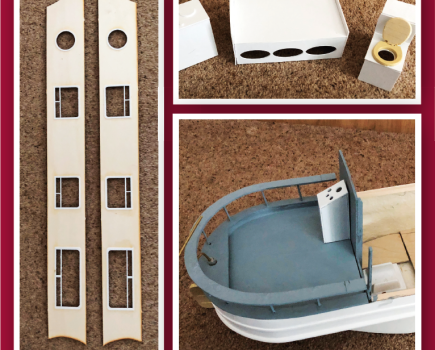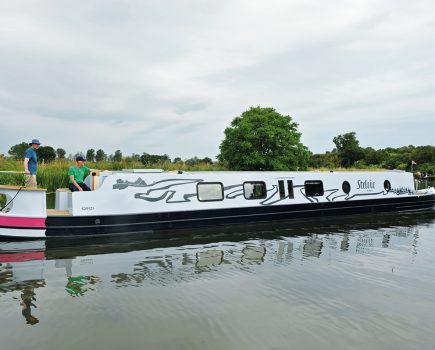Tim Coghlan attended the start of this year’s Narrow Boat Trust’s challenging autumn coal run; one of the only events to survive Covid-19

With the Covid-19 lockdown kicking in towards the end of March – and now still there in various forms – few canal events planned for this year have survived. But one that has is the Narrow Boat Trust’s autumn coal run.
Ironically amongst the earliest canalevent casualties post lockdown was its annual spring coal run, with the waterways then firmly closed. But with the waterways reopened since June, and small social gatherings permitted, the hardened members of the Narrow Boat Trust were determined to go ahead with their planned autumn coal run.
On Septmber 23, there was much excitement on the Grand Union Canal road-track towpath above Buckby Top Lock, Northamptonshire. The weather was kind – mild and windless – which was good for the group of a dozen or more volunteers who had come to hand-unload some 30 tonnes of bagged smokeless coal from two small lorries. The bags were then passed in human chains, and loaded into the holds of the awaiting pair of former working narrow boats, the motor Nutfield – owned by The Friends of Raymond – and the butty Brighton – owned by the Narrow Boat Trust.
The team managed the loading only days before the latest round of restrictions on the size of social gatherings came into force – so they were lucky to get the job done. Though not a lot of people know that, there are actually various different types of bagged smokeless fuel, and loading into the boats was according to a carefully worked-out written plan – which was constantly referred to. The bags needed to be placed in the holds to allow for unloading-to-order by type and weight en route, in such a way as not to require too much rearranging of the remaining loads to keep the trim of the boats. The whole exercise was quickly completed by midday. A young volunteer, Darren Roberts (30) said: “You would be amazed how much you can carry, once you have warmed up and got used to it. Soon we were literally throwing the 25 kg bags like rugby balls. Allowing for several tea breaks – and there a few of those – we had those boats loaded in about two hours.”
As earlier this year I had been elevated to the exalted position of an Honorary Member of the Narrow Boat Trust, and my part in the loading had at best been that of a happysnappy gongoozler, I felt that job-done, it now my duty to invite all the volunteers to cross the canal at the nearby lock and join me for a drink on Braunston Marina at the nearby reopened New Inn. We followed all the rules and sat in socially distanced small groups, as the beer and banter flowed.
The varied range of beers on offer here is always of interest, and mine was a fine pint of Courage Directors bitter, now being brewed again by Marstons as a keg beer to the old Burton recipe, and served here for the first time since reopening. That beer had been my near-downfall at university, and I then wondered if drinking it was as close to a board of directors as I would ever get. But I felt it was an appropriate choice in view of my newly elevated position within the Narrow Boat Trust.

In the finest tradition of Toad of Toad Hall, I stood up and made a fine speech wishing the team all the very best. And also expressing my heartfelt wish that we would see the Narrow Boat Trust, with their pair of boats – the restoration-in-progress motor Nuneaton and its butty Brighton – at next year’s Braunston Historic Narrowboat Rally, which had been cancelled this year.
Another victim of the lockdown had been the halting for some months, of those major restoration works to the Nuneaton, which should have been completed in time for the Braunston Rally in late June and of course this run. Now hopefully they would be completed by the end of October – thanks to a generous legacy from a late Narrow Boat Trust member. So the Nutfield was standing in instead. This was something of an irony, as the Nutfield and Brighton had been paired for a few years in the mid-50s when the boats were working for British Waterways; and now over 60 years later, they were once again working together. .
Both the Friends of Raymond and the Narrow Boat Trust had attended and been beneficiaries of those Braunston Rallies in the past in terms of fundraising and recruiting new members, which had been lost this year. In concluding my speech, I therefore promised to donate £1,000 to each from Braunston Marina. I would hand over the cheques when the boats reached Stoke Bruerne on the return run. And, for good measure, I would do the same to the Friends of the Canal Museum at Stoke Bruerne for the maintenance of the museum’s former working narrowboat Sculptor – another regular attendee at our rallies. It was starting to become a rather expensive round! But Braunston Marina is proud to give its support to preserving our ‘precious cargoes’ of former working narrowboats, and to the good people who volunteer their services to the cause, especially in these difficult times.
With loading and the pub-celebrations completed, the autumn’s run now presented a gruelling challenge for the crews. That afternoon’s run would be a bit of a gentle one, though by a way of a taste of things to come, a squall of heavy rain started just as the heavily laden pair of boats got under way. For the bystanders seeing them off, the canal seemed to have gone back to another age, with a well wrapped-up Darren Thomas steering the butty, giving the huge tiller dramatic pumping sweeps to get the boat off the bank and into deeper water.
I was reminded of that great passage in Tom Rolt’s ‘Narrow Boat’, about a night he spend in 1939 moored only a few hundred yards from where we stood: ‘That night at Norton, long after darkness had fallen, the motor-boats passed by the mouth of the junction. We could hear the penetrating and unmistakable beat of their diesel engines, the rattle of paddle ratchets at the lock, and watch the lights creeping along the lip of the embankment… We fell asleep to the sound of boats in our ears.’
Ahead was the Braunston Tunnel and down the locks to moor outside the Admiral Nelson Inn for the first night. Whenever possible the crew ate their dinner in canalside pubs, which avoided using the boats’ primitive cooking facilities.
The hard stuff would begin the next day with a run up the Grand Union to Wigrams Turn, and onto the South Oxford. The first of many ports of call was at Cropredy Wharf to unload, which would be repeated at many points along the route – to liveaboards, Thames lockkeepers, houses and village shops by the waterways more, with the back-breaking task of unloading those 30 tonnes of bagged smokeless coal by hand.
After Cropredy Wharf, it was down the Thames to Reading, with a dog’s leg onto the Kennet & Avon to Newbury, before returning to the Thames; then onto the River Wey up to Godalming; then back to the Thames and up the Grand Union to Braunston; then the North Oxford and the Coventry Canals to Tamworth, where Brighton has its home port at Alvecote Marina. The Nutfield would then run back solo to Braunston Marina – its home port.
In normal years, there was also a dog’s leg run into London on the Regents Canal, but the fear of being caught there in a lockdown had caused this to be dropped, and the load reduced from the normal 40 tonnes to 30. In all, the run take would take about four weeks.
Once underway, the pair of boats would be crewed by four enthusiasts – the two nonsteerers working the locks, with where appropriate, one going ahead on a bicycle to prepare the next one, and the other closing the paddles and gates and in narrow locks, pulling the engineless butty through.
They would sometimes be starting before dawn and tying up after dark, going non-stop all day. At night the crew of four would sleep one to each boatman’s cabin in the old way, with other two in sleeping bags in socially distanced tents in the holds. There would be crew changes along the way – roughly every week, with some returning later on. Amazingly there is no shortage of volunteers for this.
The Narrow Boat Trust – note the old spelling of narrowboat– was founded by a small group of enthusiasts in the early 1970s after regular carrying had ceased, with the intention of preserving the skills and traditions of the former working boatmen. It is a heritage-charity run entirely by volunteers, which for few years now, has operated the pair of former Grand Union Canal Carrying Company Town Class narrowboats, the motor Nuneaton and the butty Brighton. The boats were built in the mid 1930s, but never seem to have worked as a pair in their working days. The boats are kept just as they were, and the volunteers are trained to work them, as they were once worked by the working boatmen. To attract new volunteers, the catch phrase is, ‘Come and join us for a dirty weekend on Brighton!’ This is a reference to the lack of washing facilities, rather than the prospects of anything that may have crossed your mind!
Image(s) provided by:
Archant







